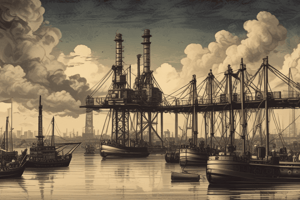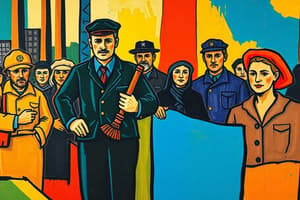Podcast
Questions and Answers
What was the main reason why safety was considered a low priority in the late 19th century?
What was the main reason why safety was considered a low priority in the late 19th century?
- Government regulations required minimal safety standards
- It was too expensive to implement safety measures
- Human labor was cheap and easily replaceable (correct)
- Workers were aware of the dangers in factories
What was the main consequence of the industrial revolution on traditional family structures?
What was the main consequence of the industrial revolution on traditional family structures?
- It strengthened family cohesion
- It led to an increase in job opportunities for families
- It disrupted traditional family structures (correct)
- It had no impact on family life
Why were children often forced to work in factories during the industrial revolution?
Why were children often forced to work in factories during the industrial revolution?
- Because there were strict child labor laws
- Due to their small size and agility for challenging tasks (correct)
- To allow them to attend school while working part-time
- Because they demanded to work alongside their parents
What was a major consequence of working in factories during the Industrial Revolution?
What was a major consequence of working in factories during the Industrial Revolution?
Who was one of the first activists to raise awareness about the condition of child laborers in the late 19th century?
Who was one of the first activists to raise awareness about the condition of child laborers in the late 19th century?
Which technological advancements revolutionized textile production during the Industrial Revolution?
Which technological advancements revolutionized textile production during the Industrial Revolution?
How did the British government respond to the growing demand for workers' rights in the late 18th century?
How did the British government respond to the growing demand for workers' rights in the late 18th century?
What was a common practice during the Industrial Revolution that raised ethical concerns?
What was a common practice during the Industrial Revolution that raised ethical concerns?
How did workplace safety conditions differ between the Industrial Revolution era and the present day?
How did workplace safety conditions differ between the Industrial Revolution era and the present day?
What motivated activists like Lewis Hine and Grace Abbott to fight for better conditions for children in the early 20th century?
What motivated activists like Lewis Hine and Grace Abbott to fight for better conditions for children in the early 20th century?
What percentage of workers constructing the Panama Canal lost their lives?
What percentage of workers constructing the Panama Canal lost their lives?
What was a significant impact of the industrial era on workplace safety?
What was a significant impact of the industrial era on workplace safety?
Flashcards are hidden until you start studying
Study Notes
- During the Industrial Revolution in the late 18th and early 19th centuries, inventions like the spinning jenny and power loom revolutionized textile production, leading to technological progress and the replacement of manual labor.
- The industrial era brought about significant bloodshed, including the deaths of cottage industry workers and ambassadors, as well as practices that left one wondering.
- During the Industrial Revolution, working in a factory meant risking your life; there were no safety regulations or concerns for workers.
- The loss of morality, destruction in the name of creation, and many other questionable practices were common during this time.
- The industrial revolution may have paved the way for the creation of iPhones, but at what cost? Today, workplace safety is a major concern for nearly every business.
- During the industrial revolution, workers had no safety concerns or regulations to follow. They were required to work long hours in dangerous conditions, often with no compensation or concern for their wellbeing.
- Two out of every five workers constructing the Panama Canal died, and one out of every fifty workers constructing the Erie Canal lost their lives. Working in a factory was literally like playing with a hot potato and a bomb.
- Industrial factories in early industrial England were reliant on the lack of transparency, as they kept their profits high by exploiting workers.
- Safety was too expensive and human labor was easily replaceable and plentiful, making it a low priority.
- The danger in the workplace was so great that one in every four days in the late 19th century saw a boiler explosion, resulting in the deaths of approximately 50,000 people per year.
- In the absence of any form of media, workers were not aware of the dangers in the factories, and the newspapers did not care about their wellbeing.
- The term "American Dream" was popularized in James Truslow Adams' 1931 book "Epic of America," but it had already become a widespread concept during the 19th century.
- The industrial revolution destroyed many cottage industries and disrupted traditional family structures, leading to an influx of people moving to the cities in search of better opportunities.
- By the time they reached the city, the opportunity had often passed, causing many new families to lose their cohesion.
- Despite the increasing number of new factories, there were never enough jobs for all the jobless migrant workers.
- Workers were treated as commodities, and skilled laborers became part of the unempathetic machinery that replaced skilled workers with mindless, cheap, identikit production.
- Factories forced workers to work long hours in dark and unsafe conditions for low wages.
- Despite the industrial revolution bringing about shorter working hours and an increase in lifespan, it also brought about the exploitation of workers, particularly children.
- Children as young as three years old were forced to work long hours in the most difficult conditions, while their parents sent them to work to make ends meet.
- Working conditions were so dangerous that adults could barely cope, but children were small and agile, making them ideal for the most challenging tasks.
- Children could not attend school because they were required to work, leading to a vicious cycle that kept them trapped in factory work.
- Jane Addams, the first American woman to win the Nobel Peace Prize, was one of the first to raise awareness about the condition of child laborers after being appalled by the lewd offers made to her by some girls in a candy factory.
- Activists like Lewis Hine and Grace Abbott later fought to improve conditions for children in the early 20th century.
- The British government saw the growing demand for workers' rights as a dangerous trend and responded with the Combination Acts of 1799 and 1800.
- When workers spoke out against inhumane and abusive practices in the factories and demanded to be treated as human beings, the British aristocracy saw it as a threat to their power and wealth.
- Fearful of losing their precious tea and croquettes, the aristocracy passed the Combination Acts to suppress the growing labor movement.- In the late 1800s, a wette was made in the UK, which is considered illegal as it sought to dissolve labor unions for the purpose of "political reform." In simpler terms, it was the abolition of the labor union for workers, making it harder for them to earn wages matching their living expenses and widening the gap between the employers and the employees.
- The Luddites, a group of British textile workers, were significantly affected by this situation as they felt obsolete due to the invention of machines. They attempted to make their plight known to the government by organizing and protesting against the industrial revolution through vandalism of nearby factories.
- The destruction of heavy machinery was intended to draw attention, but not in a positive way. In 1812, the British government passed a law making the destruction of industrial machinery capital punishment!
- This was not an empty threat - in the same year, 14 Luddites were hanged for "treason." This event marked the end of the Luddite movement and the decline of weaving as a professional craft.
- Share in the comments if you would like to know more about the harsh realities of colonial times.
Thank you for watching Nutty History.
Studying That Suits You
Use AI to generate personalized quizzes and flashcards to suit your learning preferences.




